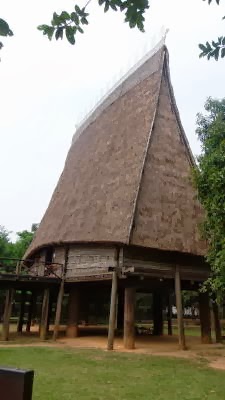First things first - every sightseeing trip around Hanoi must start with a visit to the mausoleum of Vietnam's most famous son
Ho Chi Minh Mausoleum- Die Besucher stehen geduldig,in Zweierreihen.
The Presidential Palace, built over 100 years ago to house the French Governor-General of Indochina.
Präsidentenpalast
Lake in the palace grounds (below).
Because Ho Chi Minh was too modest to live in the part of the French colonial building assigned to him.....
Hier wohnte Ho Chi Minh zunächst-
Ho's office
sein Arbeitszimmer
...he had a small and basic wooden stilt house built in the palace gardens as his residence and office on the other side of the lake in the palace gardens.
später zog er in dieses kleine Haus- noch heute besuchen viele Vietnamese darunter massenweise Schulklassen das Gelände.
The One-Pillar Pagoda, a historic Buddhist temple - clearly popular for school outings
Visit to the Museum of Ethnology which focuses on the 54 officially recognized ethnic groups in Vietnam
Below: early method of written communication
Besuch im Museum für Ethnologie - in Vietnam leben 54 ethnische Gruppen- mit zum Teil eigener Sprache und Bräuche.
Frühe gar nicht so unverständliche Schriftzeichen.
Outside exhibits represent the different types of dwelling from the various regions of Vietnam
Below: Viet house
Viethaus- die Viet sind die größte Gruppe.
Kitchen
Küche
Küche
House altar honouring dead ancestors
Ahnenaltar
Ahnenaltar
Langhaus (42m) der Ede aus der Zentralregion.
Giarai tomb house
Grab der Giarai- am Zaun wird das Leben des verstorbenen sehr explizit dargestellt.
Grave with carved water buffalo
Communal house of the Bahnar People
Versammlungshaus der Bahnar (je höher desto reicher die Gemeinde)
The Temple of Literature (below), is dedicated to Confucius, sages and scholars. It was built in 1070 and hosts the "Imperial Academy," Vietnam's first national University.
Tempel der Literatur (erb. 1070) Vietnams erste nationale Universität
The Well of Heavenly Clarity
"Quelle des himmlischen Lichts"
"Pavillon des Sternbildes der Literatur"
in front of the Confucius Temple
Räucherstäbchenopfer vor Konfuziustempel
Altar to Confucius (right) with his disciples
Konfuzius mit zwei seiner Schüler
A rector of the academy
Chu Văn An- wichtiger Rektor der Akademie (wen Interesse- siehe Wiki)
Three monarchs who contributed most to the foundation of the temple and the academy
Lý Thánh Tông (1023-1072), der den Tempel im Jahre 1070 erbauen ließ
Lý Nhân Tông (1066-1127), der die imperiale Akademie gründete.
Lê Thánh Tông (1442-1497), der die Errichtung der Steinstelen der Doktoranden veranlasste
Vietnamese noodle soup. Finally the use of chopsticks is permitted again! (In Thailand and Laos table etiquette requires the rather strange spoon and fork method)
Art Café
"Das Hawelka" von Hanoi
Hoan Kiem Lake ("Lake of the Returned Sword")
Hoan Kiem Lake (See des zurückgegebenen Schwerts)- ein bisschen Artussage, aber mit Schildkröte anstatt der Fee des Sees.
Temple of the Jade Mountain was built in the 19th century on an island in the lake, in honour of a military leader, a scholar and a confucian master
Am Ufer ist der "Tempel des Jadebergs"
Outside the temple - Hanh and Ann
Vor dem Tempel Hanh (unser Reiseführer) und Ann.
Performance of the traditional Vietnam Water Puppet Theatre
Below: the orchestra and singers
Wasserpuppentheater (Orchester und Sänger)
Curtain call: the actors behind the puppets
Schlussapplaus
Armies of mopeds make crossing the road in Hanoi a matter of life or death....
Hanois Mopedfahrer kennen keine Ampel, Vorrang, Einbahnregel, Fahrtrichtung- für Europäer sehr gewöhnungsbedürftig...
...and this is like siting in the front carriage of a roller coaster
...und besorgniserregend (vor allem wenn man (Frau) vorne in einer Fahrradrikscha sitzt.
Ride a White Swan....West Lake (Ho Tay)
West Lake bei Nieselregen
The Thang Long Imperial Citadel, built in the 11th century...
Die Thang Long Zitadelle (erb. im 11.Jht.)
...remained the seat of the Vietnamese court until 1810, when Hué became the capital
Sitz des Kaisers bis 1810
Schoolgirls celebrating graduation in the grounds of the citadel
Posieren für das Schulabschlussfoto
The royal palaces and other buildings were largely destroyed by the colonial French in the late 19th century. It became the headquarters of the colonial power for the vast regional assembly of French Indochina. Many palaces were rebuilt in a European style, such as Kinh Thiên Palace, the former heart of the Forbidden City, in 1886.
Die Franzosen richteten hier ihren Hauptstützpunkt für Indochina ein. Der kaiserliche Palast und viele andere historische Gebäude wurden zerstört und durch neue Bauten ersetzt.
Dragon steps to Kính Thiên Palace have survived.
Traditional symbols of Vietnam are the Dragon...
Die Drachentreppe zum Palast hat "überlebt"
the Phoenix...
the Turtle or Tortoise...
...but we couldn't find a Unicorn.
French colonial building used as general command headquarters for the North Vietnamese army
In diesem Gebäude war die Kommandozentrale der nordvietnamesischen Armee.
D67 - was the military underground command bunker of General Giap during the Vietnam War
D67-Bunker in der Nähe der Kommandozentrale.
Princess Palace....
with Princess...
...and a view
Hanoi Flag Tower (1805)
Fahnenturm (erb. 1805)
Watch where you walk - live spaghetti, Hanoi-style
Kabelgebilde (für Tage unverändert)
a curiously tall thin construction
Grund ist in Hanoi teuer.























































Keine Kommentare:
Kommentar veröffentlichen